Junchao Wu
RepreGuard: Detecting LLM-Generated Text by Revealing Hidden Representation Patterns
Aug 18, 2025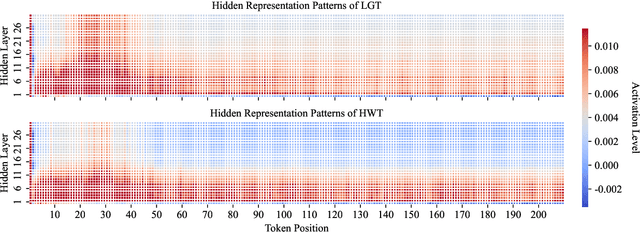



Abstract:Detecting content generated by large language models (LLMs) is crucial for preventing misuse and building trustworthy AI systems. Although existing detection methods perform well, their robustness in out-of-distribution (OOD) scenarios is still lacking. In this paper, we hypothesize that, compared to features used by existing detection methods, the internal representations of LLMs contain more comprehensive and raw features that can more effectively capture and distinguish the statistical pattern differences between LLM-generated texts (LGT) and human-written texts (HWT). We validated this hypothesis across different LLMs and observed significant differences in neural activation patterns when processing these two types of texts. Based on this, we propose RepreGuard, an efficient statistics-based detection method. Specifically, we first employ a surrogate model to collect representation of LGT and HWT, and extract the distinct activation feature that can better identify LGT. We can classify the text by calculating the projection score of the text representations along this feature direction and comparing with a precomputed threshold. Experimental results show that RepreGuard outperforms all baselines with average 94.92% AUROC on both in-distribution (ID) and OOD scenarios, while also demonstrating robust resilience to various text sizes and mainstream attacks. Data and code are publicly available at: https://github.com/NLP2CT/RepreGuard
Is Long-to-Short a Free Lunch? Investigating Inconsistency and Reasoning Efficiency in LRMs
Jun 24, 2025Abstract:Large Reasoning Models (LRMs) have achieved remarkable performance on complex tasks by engaging in extended reasoning before producing final answers, yet this strength introduces the risk of overthinking, where excessive token generation occurs even for simple tasks. While recent work in efficient reasoning seeks to reduce reasoning length while preserving accuracy, it remains unclear whether such optimization is truly a free lunch. Drawing on the intuition that compressing reasoning may reduce the robustness of model responses and lead models to omit key reasoning steps, we investigate whether efficient reasoning strategies introduce behavioral inconsistencies. To systematically assess this, we introduce $ICBENCH$, a benchmark designed to measure inconsistency in LRMs across three dimensions: inconsistency across task settings (ITS), inconsistency between training objectives and learned behavior (TR-LB), and inconsistency between internal reasoning and self-explanations (IR-SE). Applying $ICBENCH$ to a range of open-source LRMs, we find that while larger models generally exhibit greater consistency than smaller ones, they all display widespread "scheming" behaviors, including self-disagreement, post-hoc rationalization, and the withholding of reasoning cues. Crucially, our results demonstrate that efficient reasoning strategies such as No-Thinking and Simple Token-Budget consistently increase all three defined types of inconsistency. These findings suggest that although efficient reasoning enhances token-level efficiency, further investigation is imperative to ascertain whether it concurrently introduces the risk of models evading effective supervision.
Rethinking Prompt-based Debiasing in Large Language Models
Mar 12, 2025
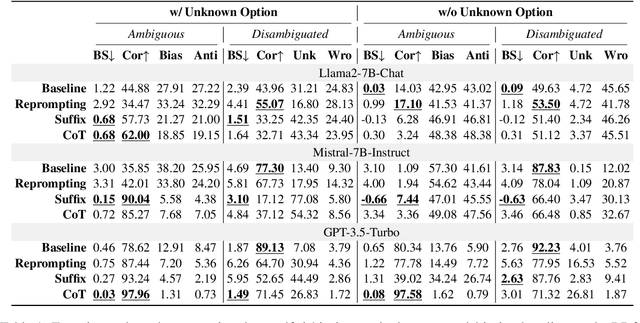
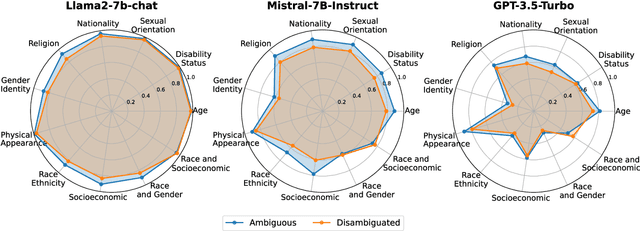
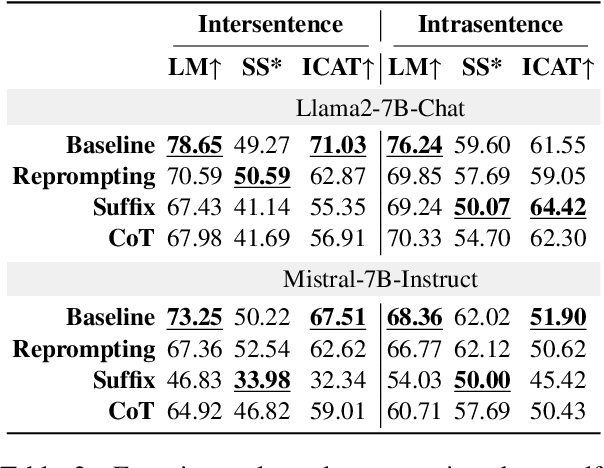
Abstract:Investigating bias in large language models (LLMs) is crucial for developing trustworthy AI. While prompt-based through prompt engineering is common, its effectiveness relies on the assumption that models inherently understand biases. Our study systematically analyzed this assumption using the BBQ and StereoSet benchmarks on both open-source models as well as commercial GPT model. Experimental results indicate that prompt-based is often superficial; for instance, the Llama2-7B-Chat model misclassified over 90% of unbiased content as biased, despite achieving high accuracy in identifying bias issues on the BBQ dataset. Additionally, specific evaluation and question settings in bias benchmarks often lead LLMs to choose "evasive answers", disregarding the core of the question and the relevance of the response to the context. Moreover, the apparent success of previous methods may stem from flawed evaluation metrics. Our research highlights a potential "false prosperity" in prompt-base efforts and emphasizes the need to rethink bias metrics to ensure truly trustworthy AI.
Can Large Language Models Identify Implicit Suicidal Ideation? An Empirical Evaluation
Feb 25, 2025Abstract:We present a comprehensive evaluation framework for assessing Large Language Models' (LLMs) capabilities in suicide prevention, focusing on two critical aspects: the Identification of Implicit Suicidal ideation (IIS) and the Provision of Appropriate Supportive responses (PAS). We introduce \ourdata, a novel dataset of 1,308 test cases built upon psychological frameworks including D/S-IAT and Negative Automatic Thinking, alongside real-world scenarios. Through extensive experiments with 8 widely used LLMs under different contextual settings, we find that current models struggle significantly with detecting implicit suicidal ideation and providing appropriate support, highlighting crucial limitations in applying LLMs to mental health contexts. Our findings underscore the need for more sophisticated approaches in developing and evaluating LLMs for sensitive psychological applications.
Fraud-R1 : A Multi-Round Benchmark for Assessing the Robustness of LLM Against Augmented Fraud and Phishing Inducements
Feb 18, 2025Abstract:We introduce Fraud-R1, a benchmark designed to evaluate LLMs' ability to defend against internet fraud and phishing in dynamic, real-world scenarios. Fraud-R1 comprises 8,564 fraud cases sourced from phishing scams, fake job postings, social media, and news, categorized into 5 major fraud types. Unlike previous benchmarks, Fraud-R1 introduces a multi-round evaluation pipeline to assess LLMs' resistance to fraud at different stages, including credibility building, urgency creation, and emotional manipulation. Furthermore, we evaluate 15 LLMs under two settings: 1. Helpful-Assistant, where the LLM provides general decision-making assistance, and 2. Role-play, where the model assumes a specific persona, widely used in real-world agent-based interactions. Our evaluation reveals the significant challenges in defending against fraud and phishing inducement, especially in role-play settings and fake job postings. Additionally, we observe a substantial performance gap between Chinese and English, underscoring the need for improved multilingual fraud detection capabilities.
DetectRL: Benchmarking LLM-Generated Text Detection in Real-World Scenarios
Oct 31, 2024
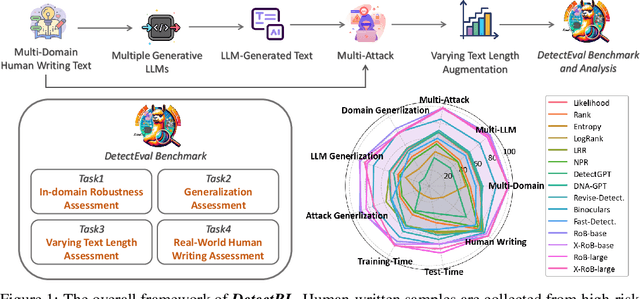
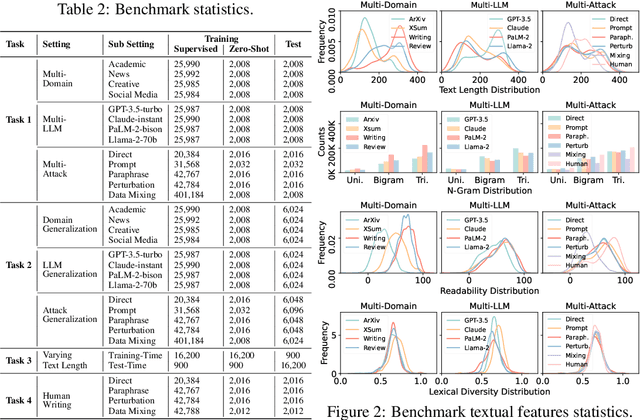
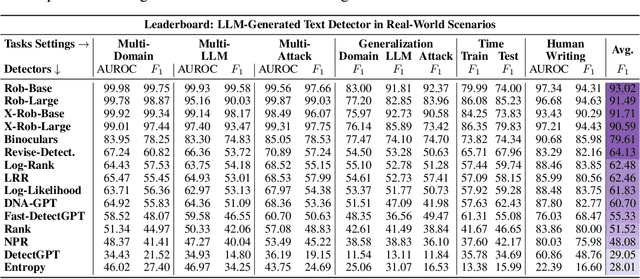
Abstract:Detecting text generated by large language models (LLMs) is of great recent interest. With zero-shot methods like DetectGPT, detection capabilities have reached impressive levels. However, the reliability of existing detectors in real-world applications remains underexplored. In this study, we present a new benchmark, DetectRL, highlighting that even state-of-the-art (SOTA) detection techniques still underperformed in this task. We collected human-written datasets from domains where LLMs are particularly prone to misuse. Using popular LLMs, we generated data that better aligns with real-world applications. Unlike previous studies, we employed heuristic rules to create adversarial LLM-generated text, simulating advanced prompt usages, human revisions like word substitutions, and writing errors. Our development of DetectRL reveals the strengths and limitations of current SOTA detectors. More importantly, we analyzed the potential impact of writing styles, model types, attack methods, the text lengths, and real-world human writing factors on different types of detectors. We believe DetectRL could serve as an effective benchmark for assessing detectors in real-world scenarios, evolving with advanced attack methods, thus providing more stressful evaluation to drive the development of more efficient detectors. Data and code are publicly available at: https://github.com/NLP2CT/DetectRL.
Who Wrote This? The Key to Zero-Shot LLM-Generated Text Detection Is GECScore
May 07, 2024



Abstract:The efficacy of an large language model (LLM) generated text detector depends substantially on the availability of sizable training data. White-box zero-shot detectors, which require no such data, are nonetheless limited by the accessibility of the source model of the LLM-generated text. In this paper, we propose an simple but effective black-box zero-shot detection approach, predicated on the observation that human-written texts typically contain more grammatical errors than LLM-generated texts. This approach entails computing the Grammar Error Correction Score (GECScore) for the given text to distinguish between human-written and LLM-generated text. Extensive experimental results show that our method outperforms current state-of-the-art (SOTA) zero-shot and supervised methods, achieving an average AUROC of 98.7% and showing strong robustness against paraphrase and adversarial perturbation attacks.
A Survey on LLM-generated Text Detection: Necessity, Methods, and Future Directions
Oct 24, 2023



Abstract:The powerful ability to understand, follow, and generate complex language emerging from large language models (LLMs) makes LLM-generated text flood many areas of our daily lives at an incredible speed and is widely accepted by humans. As LLMs continue to expand, there is an imperative need to develop detectors that can detect LLM-generated text. This is crucial to mitigate potential misuse of LLMs and safeguard realms like artistic expression and social networks from harmful influence of LLM-generated content. The LLM-generated text detection aims to discern if a piece of text was produced by an LLM, which is essentially a binary classification task. The detector techniques have witnessed notable advancements recently, propelled by innovations in watermarking techniques, zero-shot methods, fine-turning LMs methods, adversarial learning methods, LLMs as detectors, and human-assisted methods. In this survey, we collate recent research breakthroughs in this area and underscore the pressing need to bolster detector research. We also delve into prevalent datasets, elucidating their limitations and developmental requirements. Furthermore, we analyze various LLM-generated text detection paradigms, shedding light on challenges like out-of-distribution problems, potential attacks, and data ambiguity. Conclusively, we highlight interesting directions for future research in LLM-generated text detection to advance the implementation of responsible artificial intelligence (AI). Our aim with this survey is to provide a clear and comprehensive introduction for newcomers while also offering seasoned researchers a valuable update in the field of LLM-generated text detection. The useful resources are publicly available at: https://github.com/NLP2CT/LLM-generated-Text-Detection.
Human-in-the-loop Machine Translation with Large Language Model
Oct 13, 2023Abstract:The large language model (LLM) has garnered significant attention due to its in-context learning mechanisms and emergent capabilities. The research community has conducted several pilot studies to apply LLMs to machine translation tasks and evaluate their performance from diverse perspectives. However, previous research has primarily focused on the LLM itself and has not explored human intervention in the inference process of LLM. The characteristics of LLM, such as in-context learning and prompt engineering, closely mirror human cognitive abilities in language tasks, offering an intuitive solution for human-in-the-loop generation. In this study, we propose a human-in-the-loop pipeline that guides LLMs to produce customized outputs with revision instructions. The pipeline initiates by prompting the LLM to produce a draft translation, followed by the utilization of automatic retrieval or human feedback as supervision signals to enhance the LLM's translation through in-context learning. The human-machine interactions generated in this pipeline are also stored in an external database to expand the in-context retrieval database, enabling us to leverage human supervision in an offline setting. We evaluate the proposed pipeline using GPT-3.5-turbo API on five domain-specific benchmarks for German-English translation. The results demonstrate the effectiveness of the pipeline in tailoring in-domain translations and improving translation performance compared to direct translation. Additionally, we discuss the results from the following perspectives: 1) the effectiveness of different in-context retrieval methods; 2) the construction of a retrieval database under low-resource scenarios; 3) the observed domains differences; 4) the quantitative analysis of linguistic statistics; and 5) the qualitative analysis of translation cases. The code and data are available at https://github.com/NLP2CT/HIL-MT/.
 Add to Chrome
Add to Chrome Add to Firefox
Add to Firefox Add to Edge
Add to Edge